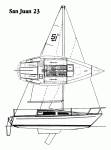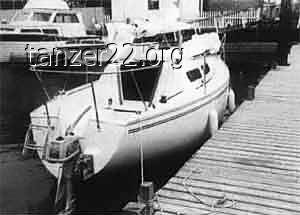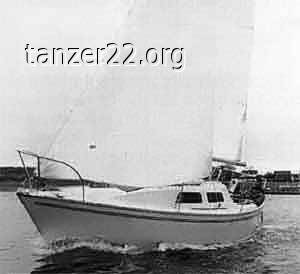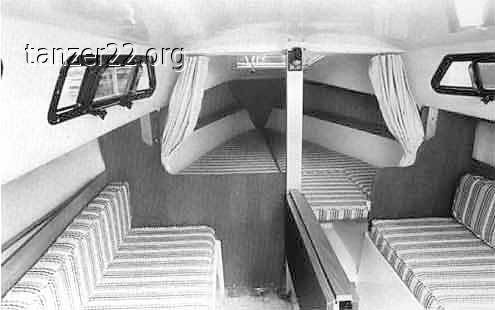
The San Juan 23 is a cruising design derived from Bruce Kirby's successful
racer, the San Juan 24.
While the SanJuan's modified "blister" house that looks so sleek on larger
racers loses some of its style when placed on a short, high-sided hull, it
does provide plenty of room below. A simple, open layout is enlarged
visually with the use of partial bulkheads. For a 23-footer, the
teak-trimmed galley is large and easily worked, but its athwartships
location beneath the companionway means you must be careful lest the crew
steps on your supper. A folding table mounted on the centerboard trunk adds
a nice, functional touch. The berths extend well into the main cabin — no
coffin quarterberths here. The settee backs are too far outboard (or the
house sides too far inboard) for sailors of normal height to sit back
without slouching or hitting their heads. This is a common problem aboard
most of the boats we sailed. Only the Tanzer and Merit avoid it with their
raised-deck construction. As in the Sirius, the San Juan's cabin sole is
carpeted.
The 23's cockpit is on the small side for more than three sailors (that's
where some of the cabin room comes from), but with its carefully angled,
14-inch deep backrests, it's most comfortable. The San Juan was the only
boat in the trials equipped with a traveller, a joy for those who take sail
trim seriously. Its location on the bridgedeck is handy for the helmsman,
but does cut into the accessibility of the companionway.
The trip forward is comparable to that on the other boats we sailed -- the
shrouds get in the way, but the foredeck is easily worked. Like the
Starwind and Sirius, an anchor locker is molded into the foredeck. The
lifeline stanchions are probably strong enough, but the posts fit loosely
into the bases and lack the secure feel of an all-welded system. Steinmetz
considered the two 5-inch mooring cleats in the stem much too small. The
two 6-inchers in the bow he felt would be barely adequate. The legitimate
chocks did make him happy. Good, chafe-reducing chocks are becoming
distressingly rare items on small production boats. Like the Starwind, the
San Juan features a swim ladder on its transom. These should not be
regarded as luxury items. On a highsided boat, they are very useful in the
event someone needs to be rescued.
The San Juan is responsive to its helm and sail controls, and beginning
sailors will learn their lessons quickly. With its racing heritage, the 23
begs for just a few go-fasts, perhaps a spinnaker or genoa or two. Good
deck space and slotted toerails should make adding the necessary hardware
fairly easy.
San Juan combines chop and roving in amounts sufficient to produce a stiff
hull. Balsa core adds additional stiffness to the deck layup without a
weight penalty. Exterior molded surfaces are smooth, fair, and uniform in
finish and color. Some interior panels showed minor fabric print-through,
but not enough to be objectionable. The 23 carries its 900 pounds of lead
ballast in a fiberglass stub-keel. The 65-pound galvanized steel
centerboard is easily handled by block-and-tackle in the cabin.





